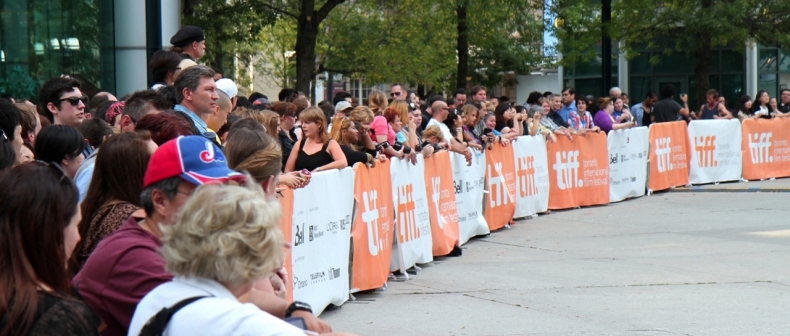
I couldn’t help but think about our public realm as I was walking home along King Street in front of the Princess of Wales Theatre last week. Caught in a Brad Pitt-obsessed throng of celebrity hunters, the dichotomy between the glitz of TIFF and the dowdiness of the nascent public plaza at the south-east corner of King and John couldn’t be more apparent. There was a former Sexiest Man Alive, used to trolling Cannes’ La Croisette, stuck glad handling the unwashed masses, who were perched on a cracked concrete plaza outside of Metro Hall.
From pure brand recognition, TIFF is Toronto’s annual coming out party. While not as widely attended as Caribana or Pride, the film festival is the only time on an annual basis that Toronto makes the international news (with the exception of our mayor) yet it becomes increasingly amusing to juxtapose the glitz and glamour of TIFF’s red carpet, now almost fully migrated to King Street, with the PoMo banality of Metro Hall. At least Penelope, the Greek restaurant facing King Street on the main floor of Metro Hall, has been renovated, replacing its ersatz white Doric columns with a more sleek marble finish.
Toronto and Torontonians have a funny relationship with the concept of “public space.” Stand in Billy Bishop Airport as a flight from Chicago arrives with a sign asking: “what did you think of Millennium Park?” and you’re bound to hear non-stop from returning tourists about how amazing their lakefront park is. Torontonians have a hard on for Millennium Park like the average person lusts after their neighbours new swimming pool come August.
Millennium Park is pretty awesome, but the construction of the 24 acre park cost a total of $475 million (it’s per acre cost clocked in at almost $20 million) or as I like to measure things in Toronto, one third the cost of the Glen Murray Subway Line to Scarborough Town Centre. By comparison, Sugar Beach -— probably the most feted of Toronto’s most recently inaugurated parks —- cost a total of $14.3 million for its two acres of white sand and pink umbrellas. Still, Torontonians like to gripe: we paid what for what!?
I was recently with a friend who commented that he hated the Museum Subway Station renovation (full disclosure: I worked for the Foundation that funded the project). “When you go to other cities, like Paris,” he argued, “their subway stations are beautiful. All Museum has are cheap looking statues.” The irony, as I suppose only my “insider” knowledge allows, is that Museum’s whimsical statues were hardly cheap (they’re coated with cool anti-graffiti paint), and with a total project cost of $5 million, the revitalization of Museum Station was not an easy project to raise money for. Comparatively, the inflated costs for Millennium Park were born by multiple corporate donors, something that would at first glance seem anathema to the concept of “public space,” and as a result, parts of the Park are named after their corporate benefactors: The Boeing Gallery, The Exelon Pavilion, or The AT&T Plaza. Museum Station, which received financial support from the Budd Sugarman Foundation, was comparatively funded almost exclusively by the aforementioned foundations (along with 13 other donors), the TTC, the province and Section 37 money.
When it comes to public space Torontonians like other people’s nice things. We just don’t want to pay for them for ourselves.
I wonder if our misgivings towards our own public space are a hangover from our protestant forefathers, wherein Toronto the Good would never have proposed something as blatantly grand, showy or somewhat unnecessary when there were libraries to build, priority neighbourhoods to fix or arguments to be had over our minimal transit lines. Witness the demolition of Sunnyside Amusement Park to make way for the endlessly infuriating Gardiner Expressway.
This is not to say that there haven’t been attempts to add a little glitz to Toronto, Dowager Countess of Upper Canada. Bloor Street’s recently completed $20 million revitalization — which saw black granite, large trees, and seasonal planters replace Toronto’s traditional cracked concrete — is the most obvious. Yet even Bloor Street’s revitalization was exemplar of our mixed feelings toward public space. A blatant attempt to mimic Chicago’s Michigan Mile, funded by the city and the Bloor-Yorkville Business Improvement Area, the project saw its fair share of controversy. A group of rogue merchants tried to sue the city and the BIA hoping to stop what they viewed as “unnecessary” construction. It seemed that for some merchants it didn’t matter that commercial rents on Bloor Street make it one of the most expensive streets in the world. They’d rather the status quo of chipped concrete rather than pay to support a revitalized “public realm.”
Bloor Street, now finished and for the most park a success, may become the high water mark of attention to public space in Toronto and it seems like it may become the anomaly rather than the norm. And still I wonder if it may be an incomplete zenith. Whatever happened to the public art component that was originally proposed?
Similar attempts to rejuvenate Torontonians’ relationship with public realm have been proposed by Toronto’s Entertainment District BIA, which would like to turn John Street, the Entertainment District’s main thoroughfare, into “a Grand Promenade.” The $28 million John Street project is currently in the environmental assessment phase. No implementation date has been set of course, because well… unless we rename it HomeSense Ave, $28 million continues to be a lot of cheddar for Toronto. The Entertainment District BIA has even looked at the aforementioned desolate plaza at King and John, holding a competition two years ago with the hopes of recasting this derelict public space into something more inviting. The winning design was called “urban ballroom” and proposed turning the South-East Corner of King and John into a space more befitting of a Mumford and Sons video. As with many things in Toronto, we’ve done studies on the matter to discuss feasibility just haven’t yet gone into implementation mode.
In some ways I think that Torontonians are resistant to a lot of these investments in our public realm because of our own attachment to our own dowdiness. There’s a quote that I love about Toronto because it so succinctly sums up the city. James Rojas, a planner from Los Angeles, after his first visit to Toronto had this to say about TO: “There’s a sort of less-than-manicured quality to the whole thing, and coupled with a huge diversity of people, the city ends up feeling gloriously messy, in a functional and walkable way.” This description, I think, describes the Toronto that so many of us love (and love to hate). Affection for our unfinished corners is the same emotion that drives our fears for Kensington Market, or hearts stoic for Little Italy with its plastic boot-shaped neon ornaments demarking an immigrant neighbourhood that is no longer so. One suspects that some Torontonians would strap themselves to those staple marked hydro polls which pock our downtown streets decrying that these too are part of our heritage.
I don’t necessarily disagree that Toronto, when it does what it does best, is messy. To place us in universally known terms: Toronto is a bit of a Betty compared to put-together Veronica. And yet there is obviously a part of our collective psyche that yearns for a little glitz and as the city becomes something other than Hogtown. Cracked sidewalks, and forgotten concrete plazas just don’t seem appropriate any longer. After all – Betty puts on a dress every now and again, doesn’t she? To be Toronto right now is to navigate these two streams: our outward Betty and our inner Veronica yearning to break free.
And, I suppose, this is where things get dicey. How does a cash strapped municipality which has paid so little attention to the public realm in the past suddenly start to change tacks? Or how does a city which has feared polarizing neighbourhoods into those with fancy sidewalks or those without — reconcile that perhaps some areas may need a little bit of a glitz?
David Mirvish, a prominent land-owner in the Entertainment District, has one answer: a condo building that will fund an art gallery and university below it. While both are not exactly public space per se, partial redemption for Toronto’s Entertainment District, itself evolving from lofts to luxury, will come through private hands, and this is Toronto’s choice. The lesson of Millennium Park has shown us that few freebies exist in the world of city building. If Toronto wants to put a little lipstick on its front end, there is going to have to be a little bit of a compromise. Toronto shall not covet thy neighbour’s house forever.
____
Jonathan Naymark is a Toronto-based writer. Follow him on Twitter @naymark.
For more, follow us on Twitter @TorontoStandard and subscribe to our newsletter.














